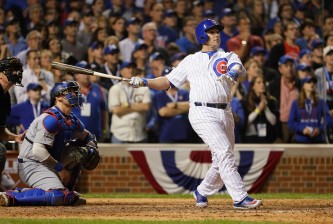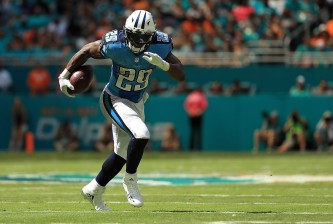Kevin Durant provided some Fourth of July fireworks, lighting up the NBA landscape with his decision to sign with the Warriors.
The Warriors stormed back from a 3-1 deficit in this year’s Western Conference finals to defeat Durant and the Thunder in seven games.
A rivalry was born, and now Durant is switching sides. A 73-win team is adding a seven-time all-star and former MVP.
Unfortunately, this isn’t the first time a star athlete has abruptly jumped to the other side of the fence in a rivalry with dollar signs in his eyes.
The eight most egregious acts of free agent betrayal are judged by the intensity of the rivalry at the time the turncoat signed with the bad guys. This is a players-only list, and the player had to go directly to the rival with no stops in between.
No. 8: Tom Glavine
Of Tom Glavine’s 305 career wins, 244 came with the Braves. The Hall of Famer won the National League Cy Young Award in 1991 and 1998. The latter came in the first of three straight seasons in which the Mets finished second to the Braves in the NL East.
The Mets fell to the Braves in six games in the 1999 National League Championship Series. Four years later, they snagged Glavine with the lefty coming off an 18-11 season.
In 2006, Glavine went 15-7 as the Mets ended the Braves’ 14-year streak of division titles. Glavine followed that up with a 13-8 season in 2007, but the Mets blew a seven-game division lead with 17 games left to play.
It was up to Glavine to save the Mets from an epic collapse on the final day of the regular season, but he allowed seven earned runs in a third of an inning as the Marlins eliminated the Mets with an 8-1 win.
Glavine’s Mets days were over. He went back to Atlanta in 2008, but had nothing left and was released in the middle of the season. He would rank higher on this list if Mets fans didn’t have the same disdain for him that Braves fans did when he left.
No. 7: Marian Hossa
The Penguins and Red Wings didn’t have an organic NHL rivalry, but they met in the Stanley Cup Finals in 2008 and 2009.
Marian Hossa was on the losing side both times, which is why he doesn’t rank higher on this list. But he did pull the Durant-like “if-you-can’t-beat-’em-join-’em” move when he signed with Detroit after the Red Wings defeated the Penguins in six games to hoist the Cup in 2008.
Pittsburgh acquired the All-Star right wing at the trade deadline, and he scored 12 goals and 14 assists in the postseason as the Penguins reached their first Stanley Cup Final in 16 years.
Unfazed by Hossa’s departure, the Penguins retooled but struggled during the 2009 season. They fired coach Michel Therrien and Dan Bylsma went 18-3-4 in his place and the Penguins returned to the Stanley Cup Finals. This time they beat Hossa and the Red Wings in seven games.
No. 6: Wade Boggs
Wade Boggs wears a Red Sox cap on his Hall of Fame plaque, but he won his championship ring with the Yankees.
It’s debatable whether or not the Yankees and Red Sox really had a rivalry in the early 1990s. The Yankees had won 22 World Series over the past seven decades and the Red Sox had won none.
So when Wade Boggs signed with the Yankees in 1993 after 11 years, five batting titles and one World Series appearance in Boston, it gave Red Sox fans one more reason to hate the Yankees.
A career .328 hitter, Boggs hit .259 for the Red Sox in 1992 and his body seemed to be breaking down. But he found his stroke again in New York and batted .311 for the Yankees in 1996.
The Yankees beat the Braves in six games to win their first World Series since 1978, and championship-starved Red Sox fans had to endure the sight of Boggs riding a horse as he celebrated the championship at Yankee Stadium.
No. 5: Curtis Martin
In 1998, another athlete spurned Boston for New York, but in this case Curtis Martin might not be the real traitor.
He did sign a six-year, $36 million contract with the Jets after rushing for 3,799 yards and 32 touchdowns in three years with the Patriots. But the puppet master in this treasonous act was Bill Parcells.
After coaching the Patriots to Super Bowl XXXI, where they lost 35-21 to the Packers, Parcells went to the Jets. Famously saying he wanted to buy the groceries if he was going to cook the meal, Parcells didn’t get the control over player personnel that he wanted in New England and ultimately had a falling out with owner Robert Kraft.
Then, a year after taking over as Jets coach, Parcells signed Martin to an offer sheet that the Patriots didn’t match. Martin ran for 1,287 yards in 1998 and the Jets reached the AFC championship game.
The Patriots, meanwhile, used their compensatory draft picks on running backs Robert Edwards and Curtis Floyd. Edwards’ career essentially ended after a promising rookie season when he tore up his knee in a flag football game before the Pro Bowl in Hawaii.
After going 10-6 in 1997, the Patriots slipped to 9-7 and a wild-card playoff exit in their first year without Martin. Then they dropped to 8-8 in 1999 and 5-11 in 2000. In 2001, the Jets did the Patriots an unintended favor when Mo Lewis knocked Drew Bledsoe out of a game and opened the door for Tom Brady.
No Patriots fan could have envisioned such a future when Martin suddenly donned Gang Green’s threads in 1998. This was one of the many cases in sports in which the athlete really couldn’t be blamed for taking the money in his peak earning years. But bitter fans don’t want to hear that.
No. 4: Ray Allen
The Celtics’ glory days were a distant memory in 2007. They finished 24-58 that year, the second-worst record in the NBA, and ended up with the No. 5 pick in the NBA draft lottery.
Celtics general manager Danny Ainge traded that pick along with Delonte West and Wally Szczerbiak to Seattle for Ray Allen.
The NBA’s all-time leader in 3-point field goals joined Paul Pierce and Kevin Garnett to form a Big Three that served as the nucleus for the team that brought the long-awaited 17th championship banner to Boston in 2008.
Allen was an All-Star in three of his five seasons with the Celtics, and averaged 11.9 points against the Heat in the 2012 Eastern Conference Finals. The Celtics took a 3-2 lead in that series before LeBron James scored 45 points in Game 6 to even the series in Boston. The Heat closed it out in Game 7 and went on to win their first title since James took his talents to South Beach.
Weeks later Allen took his pinpoint shooting touch to Miami. He rejected a two-year, $12 million offer from the Celtics and signed with the Heat for three years even though they only paid him a little over $3 million a year.
The Celtics fell to the Knicks in the first round of the 2013 playoffs. The Heat were seconds away from losing to the Spurs in the NBA Finals when Allen hit a game-tying 3-pointer with six seconds remaining in Game 6. The Heat won the game in overtime and won Game 7 for their second straight championship.
LeBron James would have won not two, but one championship in Miami if it weren’t for Allen.
Pat Riley beat the Celtics twice in the NBA Finals as Lakers coach in the 1980s, and he haunted the Celtics as Heat president by signing Allen.
No. 3: Ken Norton
Dwight Clark ignited the 49ers-Cowboys rivalry with “The Catch” in the 1981 NFC championship game, and it was rekindled in the 1990s when the teams met in three straight conference title games.
Players switched sides in this rivalry as if they were switching between skins and shirts in gym class.
Deion Sanders won a Super Bowl with the 49ers in 1994, then signed with the Cowboys and helped them win a Super Bowl the next year.
Charles Haley began and ended his career with the 49ers, but in between he was part of the Cowboys’ 1992, 1993 and 1995 championship teams, making the Pro Bowl in 1994 and 1995.
Ken Norton’s move seemed the most unnatural.
Not only did the linebacker endure the Cowboys’ 1-15 season in 1989, he also played for Tom Landry the year before. He was part of the Cowboys’ resurgence every step of the way, culminating in the 1992 and 1993 championships. He made the Pro Bowl in 1993, but jumped ship and won a ring with the 49ers in 1994.
That decision by the son of a former heavyweight champ must have felt like a punch in the gut to Cowboys fans.
No. 2: Wes Welker
Wes Welker is second on this list for a couple of reasons.
For one thing, he’s a double-dipping traitor. He went from the Dolphins in 2006 to the Patriots in 2007. The move that earns him a spot on this list, however, came in 2013.
The perpetual duel between Tom Brady and Peyton Manning stoked a rivalry between the Patriots and Broncos when Manning chose the Broncos in 2012. In Manning’s second year in Denver, he was joined by Welker after the wide receiver couldn’t agree to a deal with the Patriots.
Welker caught more passes (672) than any other player in the NFL during his six years in New England. He was part of two Super Bowl teams during that time. He went to the Super Bowl again in 2013, but it was with Manning and the Broncos.
The Broncos defeated the Patriots 26-16 in the AFC championship game to reach the Super Bowl, and a controversial play involving Welker brought the rancor to another level.
Patriots cornerback Aqib Talib left the game with a knee injury after colliding with Welker. A day later, Patriots coach Bill Belichick said that Welker intentionally took him out. Welker claimed it was a routine pick play.
The Patriots won the Super Bowl the following year while Welker caught just 49 passes in his final season with the Broncos. Welker’s career appears to be over. If it is, he’ll retire without a championship ring as all three of his Super Bowl appearances ended in defeat.
No. 1: Johnny Damon
Johnny Damon helped bring the Red Sox their first world championship in 86 years. He hit two home runs, including a grand slam, in Game 7 of the 2004 American League Championship Series at Yankee Stadium. The Red Sox became the first team in baseball history to come back from a 3-0 playoff deficit, then went on to sweep the Cardinals in the World Series.
After decades of heartbreak at the hands of the Yankees, the Red Sox finally caught up to their hated rivals. The teams split epic seven-game league championship series in 2003 and 2004 and finished tied for first in the AL East in 2005. Damon was an All-Star for the 2005 Red Sox, hitting .316.
Then he put on the pinstripes.
The Yankees signed Damon to a four-year, $52 million contract after the 2005 season. Part of the motley “Idiots” who won the championship in 2004, Damon had to shave his scruffy beard if he was going to be on George Steinbrenner’s payroll. The clean-cut Damon played a key role in the Yankees’ 2009 title, their first in nine years.
The Red Sox didn’t show Damon the money in 2005, but their fans did in 2006. The first time the Yankees took the field at Fenway Park that year, dollar bills rained down from the stands along with the mix of cheers and boos.























